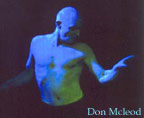




|

|
Butoh is an avant garde performance art that has its origins in Japan in the 1960's. After the second world war, Japan was a country in transition. It was a country still holding onto its old world traditional values while being forced into western democratic values by America's conquest. During this time there was much student unrest and protest. Theatre groups were performing socially challenging pieces, and there were daily demonstrations in the streets. Butoh was born out of this chaos.
Its founders were a young rebellious modern dancer named Tatsumi Hijikata (1928 -1986), and his partner Kazuo Ohno (b. 1906). Hijikata was dissatisfied with the Japanese modern dance scene, feeling that it was merely a copy of the work being done in the West. He wanted to find a form of expression that was purely Japanese, and one that allowed the body to "speak" for itself through unconscious improvised movement. His first experiments were called Ankoku Butoh, or the Dance of Darkness. This darkness referred to the area of what was unknown to man, either within himself or in his surroundings. His butoh sought to tap the long dormant genetic forces that lay hidden in the shrinking consciousness of modern man.
His first public performances were wild, primal and sexually explicit. They quite naturally shocked the conservative Japanese dance community, and he was banned from appearing at future organized events. This was the spark that gave birth to butoh. Many of Japan's dancers, poets, visual artists and theatre performers rallied around this exciting and dangerous new art form. Underground performances became increasingly popular, and soon there were numerous groups being formed in the Tokyo area. Musicians, photographers and writers, including Japan's leading novelist, Yukio Mishima, joined Hijikata to collaborate on spectacular underground performance.
 My Personal Approach to Butoh
My Personal Approach to Butoh
For me, Butoh is a way of life, a way of being fully alive in present time. Many of us spend much our conscious lives restricting the body's movement always attempting to conform to social standards of acceptable behavior. Butoh is a return to a more primal or natural way of movement like that of a child or animal.
In a year-long experiment at the American Academy of Dramatic Arts in Hollywood, I worked with 2nd year acting students using butoh training methods to help unveil their natural expressiveness. We stripped away the socially acceptable movements and gestures, and encouraged the students to find and embrace hidden movements that lie buried beneath years of conditioned behavior. When the body is freed of its social constraints ... amazing things begin to happen.
Most of my work is improvisational. I start with a theme, or a series of images and then let the body take me where it may. Many of the images I use are from my daily observations of people, animals, plants or even more obscure sources -- concepts that are found in surrealistic paintings, avant garde music and literature. A look on a stranger’s face, a memory of a dead relative, or even the shape and texture of a stone can be inspiration for a series of spontaneous movements. Kabuki and Noh theatre, Zen, Tai Chi and Chi kung are also major influences, as is the art of Ukiyo-e (Japanese prints) with its animated characters.
 Unlike most butoh performers, I use a certain amount of concrete physical imagery, and then pull back to examine that conscious state, from a more primitive perspective. I move as if discovering movement for the first time. After fifty years of trying to control my actions, this state of being is quite liberating. In my butoh, the audience receives something from my physical expressions, as if they were looking at themselves in a mirror. They may not receive the exact image that I have focused on, but they cannot mistake the imagistic process.
Unlike most butoh performers, I use a certain amount of concrete physical imagery, and then pull back to examine that conscious state, from a more primitive perspective. I move as if discovering movement for the first time. After fifty years of trying to control my actions, this state of being is quite liberating. In my butoh, the audience receives something from my physical expressions, as if they were looking at themselves in a mirror. They may not receive the exact image that I have focused on, but they cannot mistake the imagistic process.
My many years as a haiku poet have been instrumental in my being drawn to butoh as an art form. In haiku we train ourselves to be attentive to the smaller workings of humans and nature that otherwise might go unnoticed. This way of seeing is essential to creating a focused and meaningful butoh performance.
With butoh, the performer must return to a place before thought, a place where the body and mind become a blank canvas. I try to attain “a beginner's mind,” for as the great Zen master Dogen once said, “In the beginner's mind there are many possibilities, but in the mind of the expert, there are few.”
Butoh is about transformation and becoming other. From human states of being to animal to plant to mineral . . . it's the journey over the arrival. We work in a nonlinear way, compressing time into a series of elongated moments. Butoh is an earth dance, a dance of darkness and light, a dance of the human spirit defining itself through memory, tension and release.

Butoh loosely translated means stomp dance, or earth dance.
|
© Melt Magazine 2001
|